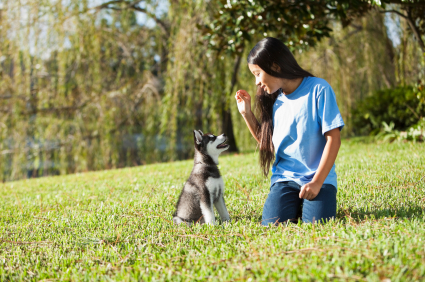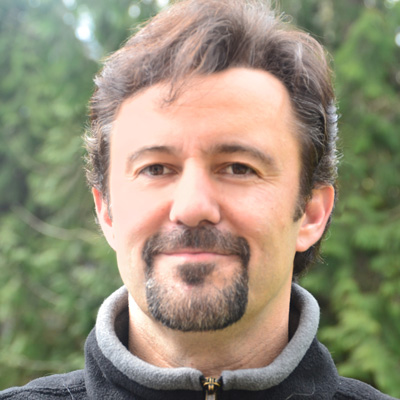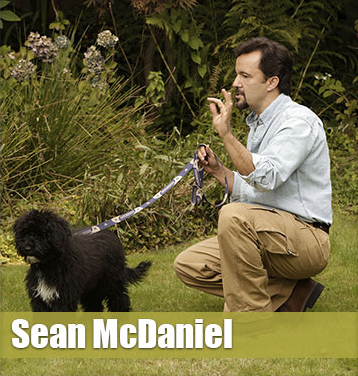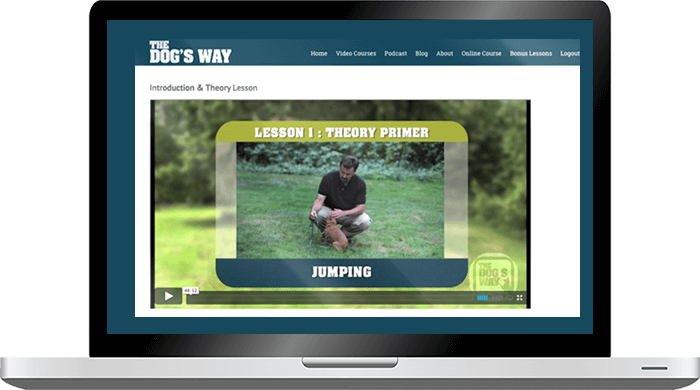How to Teach Your Older Puppy to Meet and Greet People Properly

Many people ask about this step in puppy training. A lot of times basic training seems to be going well. Your puppy is becoming more attentive, listening to you and performing basic obedience commands better during your homework sessions. However, when you’re out on a walk, whenever you see people, it all “goes out the window”. Your puppy pulls you up to the people on a tight leash, ‘goes bananas’ once they get to the person, and starts to jump, nip, mouth, whine and bark as they completely lose their mind interacting with the inevitably squealing, cooing, and petting stranger.
So, how do we remedy this temporary insanity that results from seeing people on a walk? Many times you come by this ritual honestly, because you’re told by us trainers to meet as many people as you can to socialize your pup to people. This is actually part of the problem. It’s not that socializing per se is bad advice, it’s more that it’s so consistent. That is, a puppy starts to get the pattern that everyone you see is eventually going to result in getting petted. This is the first goal we have in remedying this situation. The initial message to the puppy is, “we’re just not meeting people any more (now that’s not really true … but don’t tell your puppy that for a couple of days)
Think of the remedy for ‘greeting insanity’ with your puppy in two broad steps:
Phase 1 – The rehabilitation period: Think of this as a ‘cleansing’ of the idea that we go up to everyone we see on a walk. For a few days, you’re essentially
not going to meet anyone with your puppy. The main goal in this first phase is to be able to call your puppy away from people that you see.
Phase
2 – the actual meeting and greeting: Once you can easily call your puppy away from, and past, people from fairly close distances, you’re going to add something to your ritual. Keep in mind that this isn’t a new exercise, it’s just an add-on. So, now, with every third, fourth, or fifth person, you’re going to go up and begin meeting them again. Be aware that you shouldn’t meet every third person or every second person consistently. Your puppy will pick up the pattern and begin to disregard you. Make your meeting attempts random. It’s also important to continue doing the ‘approach and retreat’ during this process because it’s crucial that your pup realizes that they have to go up to the person while still being mentally aware of you and not by racing out ahead of you.
- Go down on one knee and essentially be down on the ground with your puppy.
- You’re also going to have 2-3 treats in your hand.
- Hold them loosely so your pup can almost get to them.
- Let them try and try and try to get the treats out of your loosely held hand during the entire meeting.
- As soon as your pup is distracted by the imminent food treats in your hand you can give your helper the cue to “go ahead – you can pet the puppy now!”
- Periodically, let them get a treat from your hand throughout the petting process.
- We only want the petting to be a few seconds and then you’re going to say, “that’s enough – Let’s go!” and you’re going to call your pup away from the person just like you’ve been doing throughout the phase one (avoiding people) period.
- As they come away with you, be sure to verbally mark (“good!”) and reward with a treat or two.
Repeat this short meeting process dozens and dozens of times until your puppy looks like they can handle 8-10 seconds of petting while being distracted by the treats in your hand. Once that happens, you can start moving your treat hand away from your pup’s nose for a few seconds at a time. You want to see if they can accept some petting for a few seconds without the distraction. If they do, verbally mark the proper acceptance of the petting with a “good!”, and then reward with a treat. Call them away as you did before and end those sessions on a good note.
Direction for your petting helpers
As you begin to give the puppy the window of a few seconds to accept petting without the active distraction of a treat on their nose the whole time, you can give you helper, that’s petting your puppy, some direction that will help condition your pup to the right behavior.
Essentially, the direction for your helper is to play and game of precisely ‘starting’ and ‘stopping’ their attention and petting, based on the puppy’s behavior. If the puppy is calm, not jumping and not mouthy, then begin petting. If the puppy starts to get mentally ‘wound up’, jumps up or mouths the helper, direct them to immediately stop petting, stand up and turn their side to the puppy. The subtext in the helpers head should be, “oh, I don’t pet overly excited, jumping, mouthy puppies!” If your helpers can do this starting and stopping of giving the pup attention consistently your puppy will quickly learn that jumping, mouthing and getting overly excited doesn’t ‘pay off’.
Let me know how this experiment goes. I look forward to hearing about your progress.


About the Author: Sean
I’ve been training people and dogs in Seattle for the last decade and a half. My main focus when working with clients every week in one-on-one, private lessons is to help people learn to get their dogs to a functional level so that they can actually enjoy spending time every day with their dog instead of stressing about their dog’s behavior issues.
One Comment
Leave A Comment
You must be logged in to post a comment.
Affiliate Program
Make money by referring people to the video course!
. . . . .

About Sean
I’ve been training people and dogs in Seattle for the last decade and a half. My main focus when working with clients every week in one-on-one, private lessons is to help people learn to get their dogs to a functional level so that they can actually enjoy spending time every day with their dog instead of stressing about their dog’s behavior issues.
Ask Sean a question!
If we use your question in the show, Sean will send you a coupon code for free access to the online video course!
If you have a question you’d like me to respond to on the show (and you want to hear yourself on a future episode) leave me a voice mail! 1 (844) 364-7929 or email me here.


How do I get my 15 week old puppy to go up calmly meeting someone. She likes to pull so she can get to the person faster and then either greet with a jump. Now I just step on the leash to avoid her jumping up but she’s all wiggles and excited. I would like her to sit when greeting but I realize with a puppy that might be difficult to do.